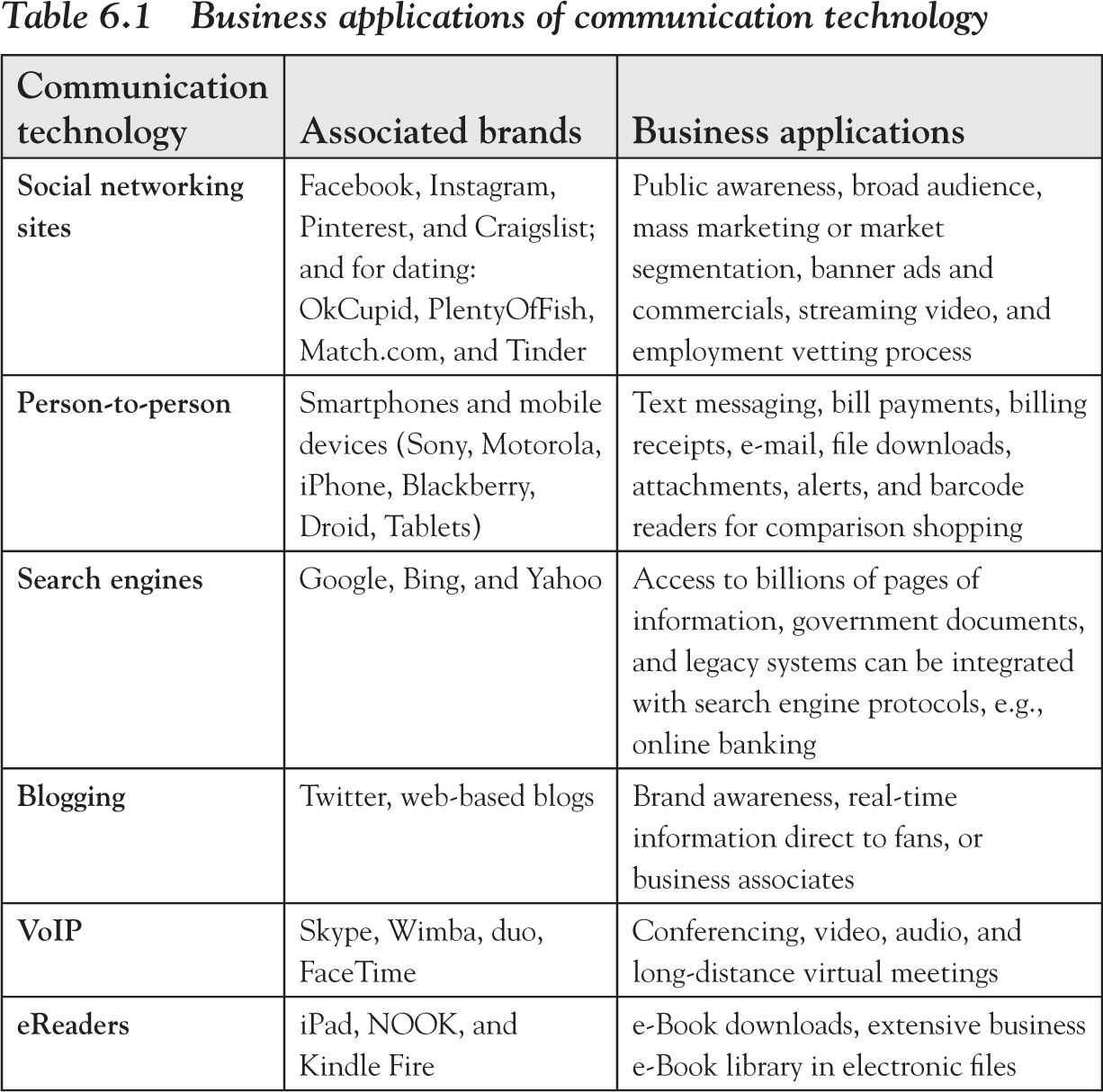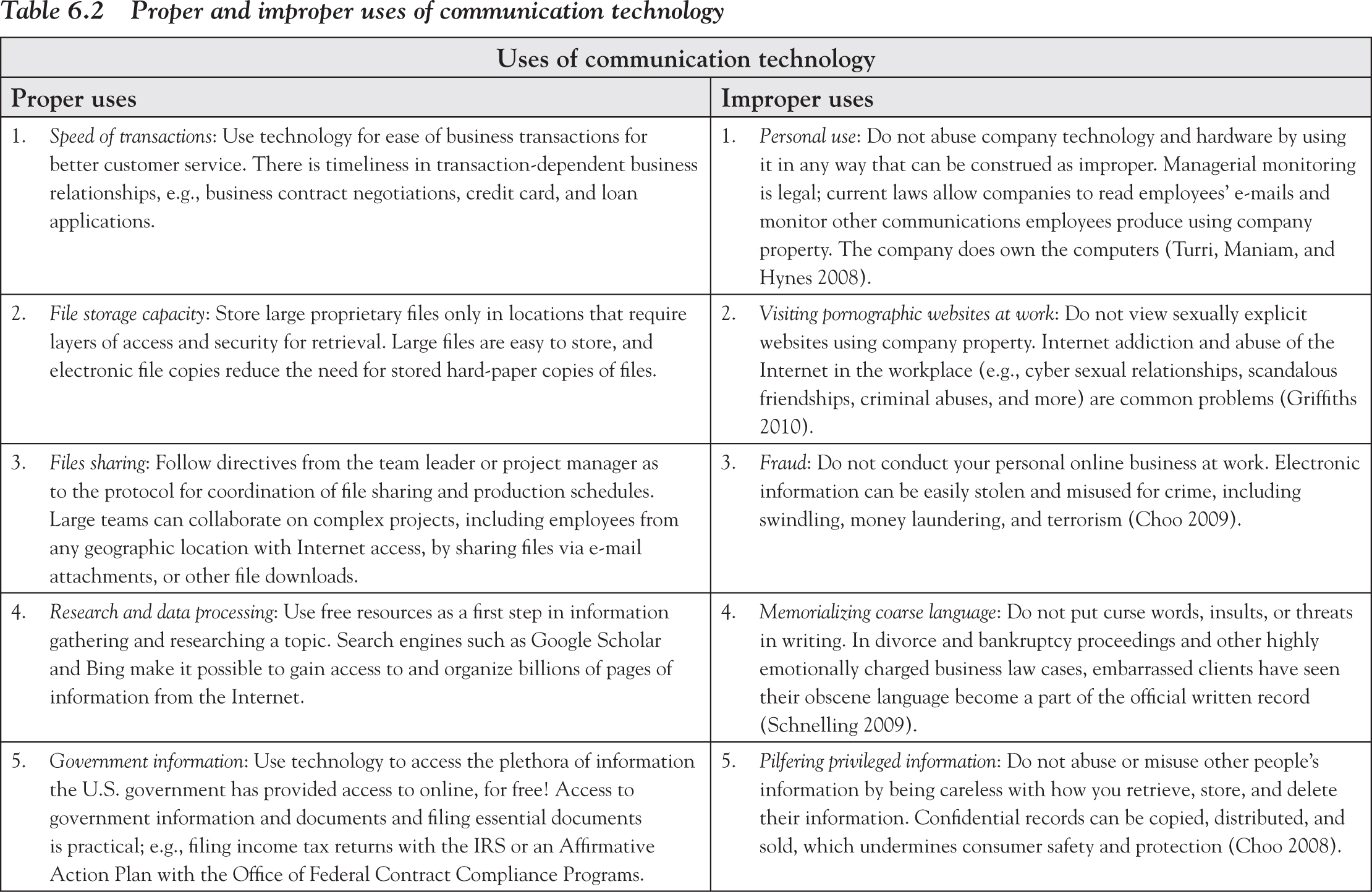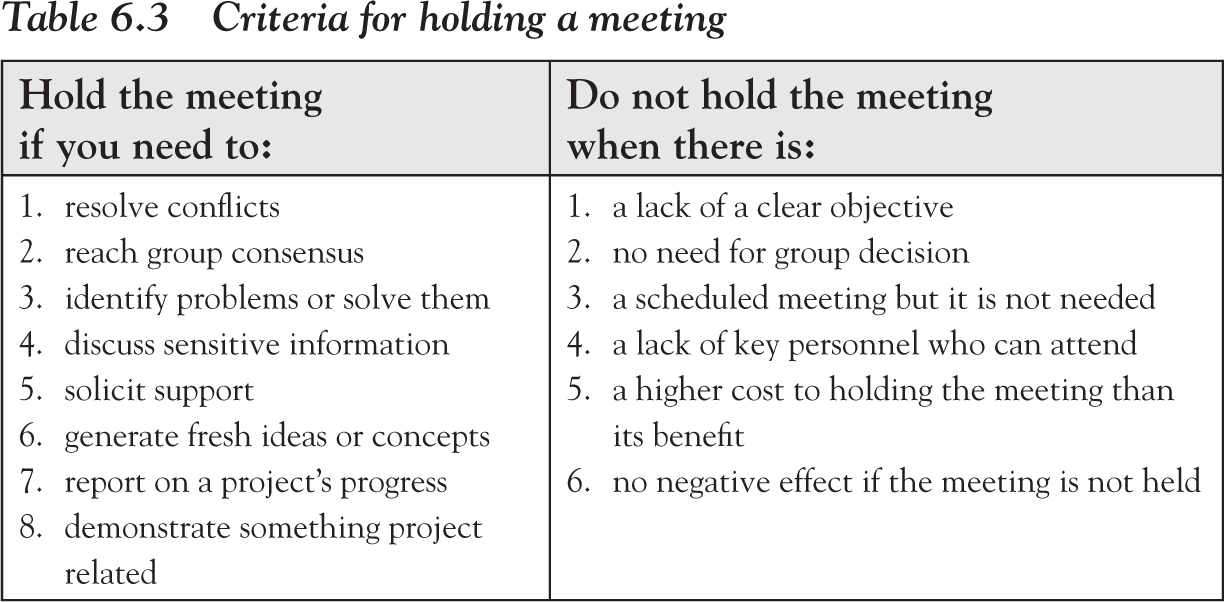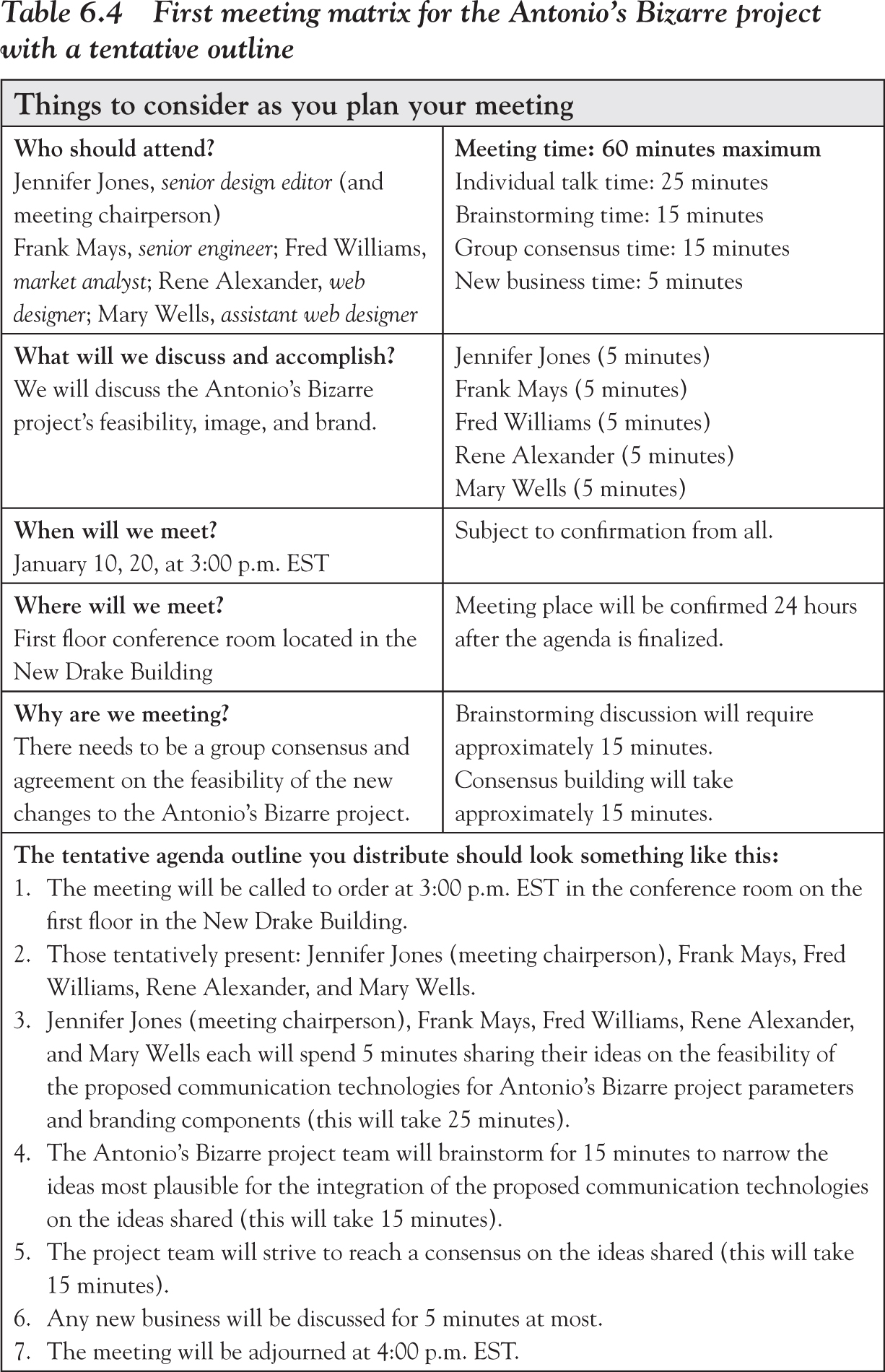Objectives
After reading this chapter, you will be able to:
- define communication technology;
- identify the proper and improper uses of communication technology in business;
- describe three guidelines for conducting business meetings;
- describe ways for conducting multicultural and virtual business meetings.
Introduction
Communication technology can be defined as any electronic system used by business people, not physically present in the same location, to exchange ideas or conduct business. The use of communication technology in today’s society is viewed by many as excessive. Electronic devices appear as appendages to many people, and technology-assisted communication invades virtually every environment, including dinners, meetings, and even religious services. People often lose their sense of what is safe while using mobile devices when driving. Thousands of vehicular accidents are reported each year involving people texting while driving. People engrossed in text messages and other handheld communication functions while operating motor vehicles have caused a significant number of injuries and fatalities, to themselves as well as others. Texting while driving poses a terrible hazard to public safety, and the U.S. Department of Transportation has recently suggested that all cell phone use by drivers be banned. Some companies, such as Dupont, have safety directives that do not allow their employees to use mobile devices while driving company vehicles. Some companies will fire individuals who have accidents while driving and using their cell phones for any purpose whatsoever.
The problems associated with drivers using cell phones is so dangerous that many jurisdictions have adopted significant restrictions on their use:
Sixteen states, D.C., Puerto Rico, Guam, and the U.S. Virgin Islands prohibit all drivers from using handheld cell phones while driving. All are primary enforcement laws—an officer may cite a driver for using a handheld cell phone without any other traffic offense taking place. No state bans all cell phone use for all drivers, but 38 states and D.C. ban all cell phone use by novice drivers, and 20 states and D.C. prohibit it for school bus drivers . . . Washington was the first state to pass a texting ban in 2007. Currently, 47 states, D.C., Puerto Rico, Guam and the U.S. Virgin Islands ban text messaging for all drivers. (GHSA 2018, para 1)
In addition to safety issues while driving, data safety is also a serious challenge as massive amounts of critical data are carried from place to place on devices that can be easily stolen or hacked.
There are other important elements as well. In this chapter, we will discuss how communication technology in business settings enables modern managers to be more efficient and effective, which includes (1) proper uses of communication technology, (2) improper uses of communication technology, and (3) conducting multicultural and virtual business meetings.
Uses of Communication Technology
Communication technology affords many beneficial opportunities for communication in organizations but also poses various possibilities for exploitation and abuse.
Beneficial Uses of Communication Technology
Social media website such as Facebook and Twitter are popular among the millennial generation, and more and more baby boomers are also signing up to connect with friends and family. Companies also use social media communications to market their ideas and products. Software applications that utilize Voice-over-Internet-Protocol (VoIP) allow users to make voice calls over the Internet. When using a webcam-enabled device, users can see and talk in real time to individuals with similarly equipped hardware and software. Two common applications used for this purpose are Skype and Apple’s FaceTime. Professionals use LinkedIn to stay in contact with friends and business associates. Instagram and Pinterest allow for photo sharing. YouTube is used widely by individuals, businesses, educational institutions, and government agencies to share video content. Any individual with a cell phone can live stream current events to the Internet in real time. In addition to enabling individuals to become overnight celebrities, live streaming enables businesses to reach the public with marketing information, testimonials of products, and messages from the CEO. Many businesses encourage their top executives to use Twitter for advertising purposes.
Individuals like their smartphones and communication devices, including the 44th president of the United States, Barack Obama. When newly elected president, Barack Obama, insisted on keeping his Blackberry, the Secret Service immediately went into action to find solutions to keep the president’s e-mail communications private. While Obama loved his Blackberry, Trump loves to use Twitter.
Since his election in 2016, President Trump has used Twitter effectively to fend off attacks from the main stream media (MSM) which he has deemed fake news. Although President Trump did not invent the phrase “fake news,” he certainly popularized it. A list of fake news sites developed by Melissa Zimdar, an assistant professor of communication at Merrimack College went viral in November 2016 (Bailey and Becker 2016). The list was intended to identify and expose fake news sites, in an attempt to help ordinary citizens sort through the thicket of information on the Internet (Zimdar 2016). However, her list was quickly used by CNN as a means of discrediting voices advocating for the president. Trump then turned the rhetoric against CNN and the MSM and has used the notion of “fake news” successfully ever since then. He now routinely antagonizes and baits these outlets in his rallies and Twitter posts with what he is now calling “very fake news” (Wallace 2016). His cunning use of Facebook and his indefatigable Twitter attacks are viewed as important elements in his defeat of Hillary Clinton for the presidency (Lapowsky 2016).
Smartphones are very useful for individuals and business because people can send and receive complete e-mails, including downloads of attachments with excellent screen resolution. Thousands of phone apps are available that allow users to perform a varied assortment of work tasks, enjoy a host of leisure activities, and engage in a myriad of consumer activities. For instance, the popular barcode reader apps for real-time price comparison shopping facilitate purchase decisions. Stores such as Sears with price guarantees find that thrifty shoppers utilize their smartphones to demand the lowest price or go elsewhere to shop for bargains.
Employees as well as private citizens use corporate blogs to find out what is happening in companies. Companies can utilize blogs for sharing information with employees before making the information available to the public on the Internet or through other media sources. Jamming involves using an internal website to educate employees and create a positive company culture. Window into Practical Reality 6.1 discusses this current use of technology by one organization.
Window into Practical Reality 6.1
Jamming at IBM
IBM started jamming in the late 1990s by using their corporate intranet to engage employees in a live companywide conversation. The idea behind the technology is to get ideas and develop new possibilities, and participants can enter and add to a jam at any time. On one occasion, the company used jamming to develop a set of work values. For 72 hours, 50,000 IBMers followed the jam, and 10,000 posted comments. IBM found that their employees participated more in this informal jamming mechanism than they did in formal meetings, perhaps because of perceived anonymity and the view that everyone’s voice was equal (Birkinshaw and Crainer 2007).
The Internet has revolutionized the job search process. For job seekers, corporate websites provide listings of available positions, along with the means to submit applications online. Resumes can often be submitted online by simply cutting and pasting into the format provided. The website also provides an easy way to find out about a company before an interview. The job of hiring agents is also simplified by having access to resumes that are arranged in the same format. Word searches can be used to identify candidates whose qualifications provide the closest match to job requirements. LinkedIn provides a convenient way for job seekers to share their credentials and also to be discovered by companies looking for potential hires who possess a specific skill set.
Smartphones do much more than provide users with the ability to make and receive phone calls. An expanding assortment of features enables users to communicate in multiple ways. Researchers have found that demographic characteristics, such as gender, age, or residence (rural or urban community), can be used to predict their usage of some phone features. For instance, female college students tend to use the e-mail feature significantly more than the game features. Tween and teenage users of communication technology devices are now the focus of targeted marketing from apparel retailers, who realize this age group cannot be reached through the more traditional media outlets (Stark et al. 2008). Victoria’s Secret’s PINK brand was developed and launched specifically for the tween demographic, and its marketing campaigns targeting this age group integrate electronic social networking to reach tweens with product offerings (Bell et al. 2011).
Managers must make an effort to keep up with new technology and learn how to use it properly in business settings. Obviously, the younger the employees, the more in tune they will likely be with new technologies. Some examples of popular communication technology applications and their uses for business are shown in Table 6.1.

A firm’s ability to react quickly in providing current information to customers can be crucial to its image and reputation. For example, an insurance company can make use of social media after a natural disaster to provide policy holders with current claim contact phone numbers in the event the client has experienced a loss.
Companies can also interface more effectively with their internal constituents because of web 2.0 technologies that make it easy to develop wikis, blogs, podcasts, and online training programs. Younger generations tend to go to these sources for information more frequently than they do to newspapers, magazines, or news programs.
Improper Uses of Communication Technology
Companies recognize the benefits of communication technologies for collaboration, communication, and networking. However, while recognizing the enormous potential for customer development externally and employee communication internally, they have legitimate concerns about risks to proprietary information, privacy, and security. One law that affords protection to electronic communication in the United States is the Electronic Communications Privacy Act (ECPA). The ECPA extended the provisions of the Federal Wiretap Act of 1968, which addressed interception of conversations using “hard” telephone lines, but this did not apply to interception of computer and other digital and electronic communications (U.S. Department of Justice, Office of Justice Programs 2013). The current law dictates that employers must notify their employees when Internet usage is monitored. Once notified, employees who use the system have given their implied consent to the monitoring.
Using technology to steal information is relatively easy. Cyber stalkers and other Internet criminals are not limited to one geographic location. Hacking can occur in a wide variety of ways. Credit card information can be stolen when people swipe their cards at the point of sale, personal and financial information can be hacked from computers or mobile devices when using unsecured Internet connections or when lacking updated security software, and sensitive information can be intercepted by viewing or listening to communications over wireless networks. Individuals must be aware that their devices are susceptible to hacking and ensure that adequate measures are taken to secure their data.
Some abuses of technology are not necessarily illegal, yet they pose serious ethical questions. An example of risky behavior involving technology is the practice of sexting (people forwarding nude photos of themselves to friends or complete strangers they find online). These photos can be repeatedly forwarded and also land on pornographic websites. A number of politicians and celebrities have suffered embarrassment and loss of status after being exposed through sexting. Another communication practice of ethical concern is cyber bullying—the use of electronic devices to convey messages of hate, hostility, and violence.
Cyber bullying at work can also occur when people use technology to say things that should be discussed in a face-to-face setting but instead are done online behind someone’s back. A person can be bullied at work by a supervisor, who makes inappropriate comments (e.g., memorializing disparaging comments in a permanent record). Sometimes participating in a company debate by responding to an internal request for feedback on a controversial topic can backfire on the respondent, as is the case with James Damore, former Google engineer. Damore was fired for harassment for comments he sent in a memo. Damore wrote a manifesto on women’s “choices” attempting to explain why women are underrepresented in science, technology, engineering and math (STEM) subjects. When his leaked internal 10-page memo went viral, Damore was fired from Google. Damore is now suing Google for discrimination against him based on his race, gender, and rights to free speech; his class action lawsuit, now joined by others, apparently has legal standing and is slowly making its way through the hierarchy of the courts (Guynn 2018). Communication technology misuse can have long-lasting negative effects on victims. The courts will determine if Damore’s attempt to participate in a controversial Google-driven debate on the lack of women in STEM was an exercise in his free speech, and if his termination from Google was wrongful; conversely, the courts might side with Google that Damore exemplified hate speech and bullying in his memo that went viral.
Texting has become quite popular with business for both internal and external communication purposes. A whole abbreviation language has emerged, for instance OOO (out of office), FYI (for your information), and EOD or EOB (end of day or business). While texting is useful for quick exchange of information, business activity often necessitates a more formal record of communication for verification and historical reference. The use of texting has become very popular among businesses. In addition, phone companies do have permanent records of text messages, which can be subpoenaed for legal purposes (Burke 2015). Other forms of written communication such as e-mail provide such a record, and phone conversations are easily recorded for historical purposes. Correct grammar and spelling and careful use of abbreviations is important in texting for business, as it conveys an appropriate tone and helps the receiver decode your message properly.
Abuses of technology take many forms, such as getting into e-mail or texting arguments or using technology to layoff or fire employees rather than confront them face-to-face. It’s not generally a good idea for employees to tweet or make negative comments on their Facebook page about a manager or the company. While the company may not like such communication, courts have ruled in favor of the employee in several cases as illustrated in Window into Practical Reality 6.2.
Another example of communication technology abuse is the sharing of classified and confidential information with unauthorized parties. A recent incident at the Pentagon posed a threat to U.S. national security when Bradley Manning, a 22-year-old soldier, leaked nearly 750,000 military files and classified U.S. intelligence reports to an internationally based public protest website called WikiLeaks. Manning confessed and pleaded guilty to dozens of charges. Manning was subsequently court-martialed and served 7 years in federal prison. Manning’s information theft is one on the most publicized cases of communication technology abuses in recent memory. Manning has since been released from prison, due to Obama’s grant of clemency, and now has transitioned and identifies as Chelsea Manning (Kube and O’Hara 2017).
Window into Practical Reality 6.2
A Woman Is Illegally Fired for Remarks
A woman posted disparaging remarks about her manager on her Facebook page and was fired shortly afterward. The employee sued and won, with the court stating that the online post was no different than talking at the water cooler. Employees have a right to talk about their employers according to the Federal Labor Laws, and states with employment-at-will laws do not necessarily have the right to arbitrarily fire-at-will for reasons that are not legal (Hananel 2010). While not necessarily deemed illegal, what are the potential implications of posting disparaging comments about one’s employer on social media sites?
Employee privacy and employer rights frequently clash. When employees use a company computer or device, the company will probably win a legal battle over disputed communication. When employees use their own computers or devices; however, protection of free speech will likely apply. An employee does not have a reasonable assumption of privacy when using work equipment, and the company has the right to block Internet sites. Firing people for abusing the Internet or using the Internet to go to inappropriate Internet sites is not unusual (Turri, Maniam, and Hynes 2008). Therefore, company e-mail systems should not be used for personal messages, and personal e-mails using a private e-mail address (Yahoo, Gmail, and so on) should only be sent and answered during breaks or lunchtimes and not during work hours.
Table 6.2 shows examples of proper uses and improper uses of communication technology usage.

Conducting Technology-Assisted Meetings
One of the positive impacts of communication technology for internal business activity is its usefulness for planning and conducting meetings. More than 20 years ago, Munter (1992) provided some guidelines that remain relevant for conducting a business meeting (1) preparation, (2) participation, and (3) decision making and follow-up. All are crucial for conducting a meeting successfully, whether in person or virtually. Furthermore, knowing when you should and should not conduct a meeting is a skill that will help you preserve your reputation among your colleagues and peers. They will be more likely to participate in your meetings, if they know you call meetings only when they are absolutely essential.
Preparation
Before calling any business meeting, there should always be a valid reason to meet. People in business loathe having their time wasted. Therefore, it is good to know if a meeting should be called or if an alternative to a meeting would suffice. Drew (1994) suggests several reasons when you should conduct a meeting and reasons when you should not conduct a meeting, as summarized in in Table 6.3:

Once you have decided that a meeting is necessary, you must prepare for the meeting. A crucial part of meeting preparation includes writing an agenda which requires that five questions be answered: Who should attend your meeting? What will be discussed and accomplished at your meeting? When will the meeting take place? Where will the meeting take place—face-to-face or virtually? Why is the meeting essential or necessary? An illustration of answers to these questions is presented in Table 6.4, which is developed in preparation for a meeting of design engineers and a senior design editor, Jennifer Jones. Answering the aforementioned questions will save you a lot of time as you plan.
People need to know that the meetings they attend are necessary, and what will be accomplished that otherwise could not be accomplished without a meeting; these are important whether the meeting is face-to-face or virtual. Be sure whenever possible that the length of the meeting is not more than 1 hour. Break the total time into allotments. Make sure that each person is aware that he or she will need to come prepared for the meeting by associating each name with a topic or allotment of time. Distribute the agenda, and give each person a 24-hour deadline to make suggested changes to it.
Finalize the agenda once everyone expected to attend has made comments, or after the 24-hour deadline has lapsed. When possible, plan your meeting at least 1 week in advance of the scheduled meeting time.
Finalize the agenda once the meeting time and location is reserved. In the event that situations change or the meeting place is unavailable, you might need to reschedule the meeting, but the agenda action items can stay the same.
Participation
The agenda action items become the meeting minutes. Taking the minutes for a meeting is the chairperson’s responsibility, although this can be assigned to another member of the committee or team or to an administrative assistant. Meeting minutes are different from transcription notes. Only the key points of the discussion and the items agreed upon should be reflected in the meeting minutes. For example, people speak at a rate of 150 words per minute on average. A 60-minute meeting means that if all words were recorded, the minutes would be the size of a novella. Thus, a 60-minute meeting should result in about one page of minutes. Each of the action items on the agenda represents a line item in the meeting minutes. Record only the key points of the discussion and what points were agreed upon.
Ask questions directly to those who are not actively participating. For those persons who talk too much or dominate the discussion, politely remind them that they will have or have had their 5 minutes. Then, politely ask the person whose turn it is to speak. This encouragement may be especially needed for persons from cultures where speaking out of turn or being too forward is considered rude behavior. During brainstorming, it is the chairperson’s responsibility to be sure that criticisms of ideas are avoided and that good ideas are being generated. When it is time to narrow the ideas, ask each person to write down his or her top two or three. Then, hear from each person as the group narrows the ideas. If necessary, use Robert’s Rules of Order for deciding on issues. Using voting and majority rule is a good strategy for formal meetings.
Decision Making and Follow-Up
When it is necessary to make a decision, it can be done either by a secret ballot or by raising hands for a yea or nay vote. If it is a sensitive matter, it is probably best to use a secret ballot; if it is not sensitive, then raising hands tends to be faster. Meeting management software can be used in face-to-face and virtual meetings to facilitate the capture and presentation of ideas and anonymous voting.
Once something is decided, the person who will implement the idea will need to be told, and there needs to be a follow-up that the idea was actually put into action.
Conducting Multicultural Business Meetings
Most cultural differences occur because the things people hold dear, value, and believe are not universally accepted. Conducting a multicultural business meeting means that managers must deal effectively with the tensions caused by competing cultures. Managers must also anticipate and reasonably accommodate cultural sensitivities and expectations. Finally, managers will need to recognize and overcome barriers to communication spawned from language idioms, expressions that cannot be translated, and nonverbal behaviors and cues.
In order to manage tensions, speak more slowly than normal, but not louder than normal. Asking questions is a way to be sure that others understand you and you understand them. Be sure that all individuals express their views. Those from some cultures will not share information unless the leader asks for their ideas. Realize that in certain cultures it is rude to give someone credit individually and that it is only correct to credit the whole group. Language will always be a problem in intercultural meetings. Though English might be the official choice, remember that it may be a second or third language for some of the people in the meeting. Using visuals is important so that people can see and read as well as hear what is being said. Remember that meanings of words can be very confusing. A case in point is the expression to table. When we table something in the United States, it means we are putting it aside to take up at a later time. In England, to table means to take up the matter immediately. Take nothing for granted and ask lots of questions to clarify anything that does not seem clear.
Anticipating and accommodating cultural sensitivities means being aware that everyone is not like you. If you are a female, this may entail wearing concealing clothing. Or, if people eat with their fingers, you might resist requesting a fork and eat with your fingers as well. Learning to eat with chop sticks will impress your Asian counterparts. Respect customs that are important to members of other cultural groups. For instance, if you are working with Muslims, they will be praying five times during the day; and during Ramadan they will be fasting, so not eating in front of them would be considerate. Talk to people and ask them about their culture; most people enjoy educating others about their country and people. Most importantly, if you make a mistake apologize, and do not be afraid to laugh at yourself. Removing communication barriers means learning what the other culture expects. Asking questions of your counterpart will show an interest on your part and encourage the other person to ask questions of you.
Conducting Virtual Business Meetings
Virtual meetings save on travel time and expense and are becoming increasingly popular in global business organizations. To a large degree, virtual meetings are like face-to-face meetings; and therefore, should follow the guidelines previously discussed. Global teams, however, have all the usual communication challenges, plus there may be team members who have never met face-to-face, who are in different time zones, and for which the technology may not be equivalent. It is difficult to establish relationships through technology, so meetings will probably not flow as easily as they do when everyone is face-to-face in the same meeting room. As a leader of a virtual team, take extra time to greet the members as they join the meeting, using small talk and showing personal interest, much as you would in a live meeting. Remember when you are setting up meetings that holidays around the world are different, so have a calendar of each country handy as you plan. Additionally, consider the time zone differences. While there may be no one time that works well for everyone, alternate so that the same people will not consistently have to meet in the middle of the night or the wee hours of the morning.
Because attention is harder to keep during virtual meetings, ask all participants to set their phones on mute so they can hear but will not cause distraction with background noises or coughing. Use the whiteboard feature in your meeting management software to encourage all participants share ideas. Consider the use of webcams, so that everyone can have a face attached with the name. Be sure to take notes and send them to everyone to be sure they are complete and that everyone understands what was discussed and what actions need to be taken.
You may need to poll people to get them into the discussion. Some may feel that their English is not good enough or that their opinions are not important. Allow people to use the whiteboard and type responses if they feel more comfortable doing that. If individuals are from different layers within the company, you may need to level the playing field by emphasizing that everyone’s ideas are important and critical to what is being discussed.
Virtual meetings do require more effort than face-to-face meetings, if they are to be successful. Many organizations provide virtual meeting rooms that attendees can use while engaged in a virtual meeting, complete with a computer that has a camera, as well as Wimba, Skype, or a similar application that allows participants to be seen and heard. Other screen-sharing technologies are available for hosting online meetings such as Cisco’s Telepresence.
When people do not participate in discussion, they are only accepting information rather than exchanging it. If they have something to say, it should be shared with the entire group. Making people feel a part of a team is very important in virtual meetings.
Summary
A broad definition of communication technology is electronic systems used for communication between individuals or groups. We define communication technology narrowly because of its usage by business persons for business reasons as any electronic system used by business persons that fosters improved communication in their goal achievements.
Technology affords a wide array of opportunities for improving and enhancing communication, yet it is not without its pitfalls. People are making wide use of technology to impact their social exchanges, their consumer activities, and their employment endeavors. Businesses use technology to carry their marketing message and to communicate more effectively with employees and other stakeholders. Some general pitfalls of communication technology usage are that people seem to lose their sense of discretion when using mobile devices in public and personal and public safety can be compromised, as when driving or when a device containing sensitive information is lost or stolen. Some people using technology to engage in sexting, which can result in embarrassment and remorse. Cyber bullying can be used by people in the workforce as well as by people in the private sector to insult, belittle, or threaten others.
Technology can be assistive to business meetings, whether face-to-face or virtual. Three guidelines for conducting a business meeting include (1) preparation, (2) participation, and (3) decision making and follow-up. Multicultural and virtual meetings pose additional challenges. Conducting a multicultural business meeting means managers must deal with the tensions caused by competing cultures, anticipate and reasonably accommodate cultural sensitivities and expectations, and effectively remove communication barriers. Virtual meetings can save companies significant time and money by making it possible for people in different parts of the world to meet. Virtual teams must overcome the challenges of loss of personal contact, time differences, and technology insufficiencies to bring about favorable outcomes.

